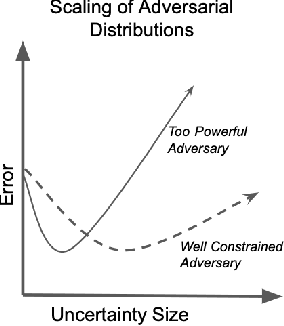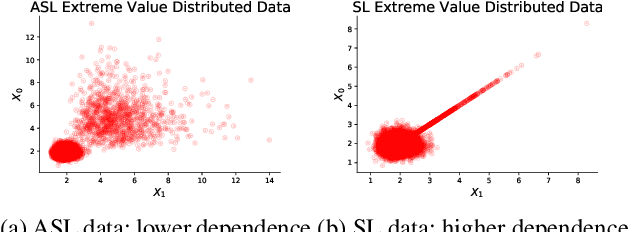Jose Blanchet
Duality and Policy Evaluation in Distributionally Robust Bayesian Diffusion Control
Jun 24, 2025Abstract:We consider a Bayesian diffusion control problem of expected terminal utility maximization. The controller imposes a prior distribution on the unknown drift of an underlying diffusion. The Bayesian optimal control, tracking the posterior distribution of the unknown drift, can be characterized explicitly. However, in practice, the prior will generally be incorrectly specified, and the degree of model misspecification can have a significant impact on policy performance. To mitigate this and reduce overpessimism, we introduce a distributionally robust Bayesian control (DRBC) formulation in which the controller plays a game against an adversary who selects a prior in divergence neighborhood of a baseline prior. The adversarial approach has been studied in economics and efficient algorithms have been proposed in static optimization settings. We develop a strong duality result for our DRBC formulation. Combining these results together with tools from stochastic analysis, we are able to derive a loss that can be efficiently trained (as we demonstrate in our numerical experiments) using a suitable neural network architecture. As a result, we obtain an effective algorithm for computing the DRBC optimal strategy. The methodology for computing the DRBC optimal strategy is greatly simplified, as we show, in the important case in which the adversary chooses a prior from a Kullback-Leibler distributional uncertainty set.
DRO: A Python Library for Distributionally Robust Optimization in Machine Learning
May 29, 2025Abstract:We introduce dro, an open-source Python library for distributionally robust optimization (DRO) for regression and classification problems. The library implements 14 DRO formulations and 9 backbone models, enabling 79 distinct DRO methods. Furthermore, dro is compatible with both scikit-learn and PyTorch. Through vectorization and optimization approximation techniques, dro reduces runtime by 10x to over 1000x compared to baseline implementations on large-scale datasets. Comprehensive documentation is available at https://python-dro.org.
Wasserstein Distributionally Robust Regret Optimization
Apr 16, 2025Abstract:Distributionally Robust Optimization (DRO) is a popular framework for decision-making under uncertainty, but its adversarial nature can lead to overly conservative solutions. To address this, we study ex-ante Distributionally Robust Regret Optimization (DRRO), focusing on Wasserstein-based ambiguity sets which are popular due to their links to regularization and machine learning. We provide a systematic analysis of Wasserstein DRRO, paralleling known results for Wasserstein DRO. Under smoothness and regularity conditions, we show that Wasserstein DRRO coincides with Empirical Risk Minimization (ERM) up to first-order terms, and exactly so in convex quadratic settings. We revisit the Wasserstein DRRO newsvendor problem, where the loss is the maximum of two linear functions of demand and decision. Extending [25], we show that the regret can be computed by maximizing two one-dimensional concave functions. For more general loss functions involving the maximum of multiple linear terms in multivariate random variables and decision vectors, we prove that computing the regret and thus also the DRRO policy is NP-hard. We then propose a convex relaxation for these more general Wasserstein DRRO problems and demonstrate its strong empirical performance. Finally, we provide an upper bound on the optimality gap of our relaxation and show it improves over recent alternatives.
Learning an Optimal Assortment Policy under Observational Data
Feb 10, 2025Abstract:We study the fundamental problem of offline assortment optimization under the Multinomial Logit (MNL) model, where sellers must determine the optimal subset of the products to offer based solely on historical customer choice data. While most existing approaches to learning-based assortment optimization focus on the online learning of the optimal assortment through repeated interactions with customers, such exploration can be costly or even impractical in many real-world settings. In this paper, we consider the offline learning paradigm and investigate the minimal data requirements for efficient offline assortment optimization. To this end, we introduce Pessimistic Rank-Breaking (PRB), an algorithm that combines rank-breaking with pessimistic estimation. We prove that PRB is nearly minimax optimal by establishing the tight suboptimality upper bound and a nearly matching lower bound. This further shows that "optimal item coverage" - where each item in the optimal assortment appears sufficiently often in the historical data - is both sufficient and necessary for efficient offline learning. This significantly relaxes the previous requirement of observing the complete optimal assortment in the data. Our results provide fundamental insights into the data requirements for offline assortment optimization under the MNL model.
Non-linear Quantum Monte Carlo
Feb 07, 2025Abstract:The mean of a random variable can be understood as a $\textit{linear}$ functional on the space of probability distributions. Quantum computing is known to provide a quadratic speedup over classical Monte Carlo methods for mean estimation. In this paper, we investigate whether a similar quadratic speedup is achievable for estimating $\textit{non-linear}$ functionals of probability distributions. We propose a quantum-inside-quantum Monte Carlo algorithm that achieves such a speedup for a broad class of non-linear estimation problems, including nested conditional expectations and stochastic optimization. Our algorithm improves upon the direct application of the quantum multilevel Monte Carlo algorithm introduced by An et al.. The existing lower bound indicates that our algorithm is optimal up polylogarithmic factors. A key innovation of our approach is a new sequence of multilevel Monte Carlo approximations specifically designed for quantum computing, which is central to the algorithm's improved performance.
Limit Theorems for Stochastic Gradient Descent with Infinite Variance
Oct 21, 2024Abstract:Stochastic gradient descent is a classic algorithm that has gained great popularity especially in the last decades as the most common approach for training models in machine learning. While the algorithm has been well-studied when stochastic gradients are assumed to have a finite variance, there is significantly less research addressing its theoretical properties in the case of infinite variance gradients. In this paper, we establish the asymptotic behavior of stochastic gradient descent in the context of infinite variance stochastic gradients, assuming that the stochastic gradient is regular varying with index $\alpha\in(1,2)$. The closest result in this context was established in 1969 , in the one-dimensional case and assuming that stochastic gradients belong to a more restrictive class of distributions. We extend it to the multidimensional case, covering a broader class of infinite variance distributions. As we show, the asymptotic distribution of the stochastic gradient descent algorithm can be characterized as the stationary distribution of a suitably defined Ornstein-Uhlenbeck process driven by an appropriate stable L\'evy process. Additionally, we explore the applications of these results in linear regression and logistic regression models.
Optimal Downsampling for Imbalanced Classification with Generalized Linear Models
Oct 11, 2024



Abstract:Downsampling or under-sampling is a technique that is utilized in the context of large and highly imbalanced classification models. We study optimal downsampling for imbalanced classification using generalized linear models (GLMs). We propose a pseudo maximum likelihood estimator and study its asymptotic normality in the context of increasingly imbalanced populations relative to an increasingly large sample size. We provide theoretical guarantees for the introduced estimator. Additionally, we compute the optimal downsampling rate using a criterion that balances statistical accuracy and computational efficiency. Our numerical experiments, conducted on both synthetic and empirical data, further validate our theoretical results, and demonstrate that the introduced estimator outperforms commonly available alternatives.
Distributionally Robust Optimization as a Scalable Framework to Characterize Extreme Value Distributions
Jul 31, 2024



Abstract:The goal of this paper is to develop distributionally robust optimization (DRO) estimators, specifically for multidimensional Extreme Value Theory (EVT) statistics. EVT supports using semi-parametric models called max-stable distributions built from spatial Poisson point processes. While powerful, these models are only asymptotically valid for large samples. However, since extreme data is by definition scarce, the potential for model misspecification error is inherent to these applications, thus DRO estimators are natural. In order to mitigate over-conservative estimates while enhancing out-of-sample performance, we study DRO estimators informed by semi-parametric max-stable constraints in the space of point processes. We study both tractable convex formulations for some problems of interest (e.g. CVaR) and more general neural network based estimators. Both approaches are validated using synthetically generated data, recovering prescribed characteristics, and verifying the efficacy of the proposed techniques. Additionally, the proposed method is applied to a real data set of financial returns for comparison to a previous analysis. We established the proposed model as a novel formulation in the multivariate EVT domain, and innovative with respect to performance when compared to relevant alternate proposals.
Generative Learning for Simulation of Vehicle Faults
Jul 30, 2024Abstract:We develop a novel generative model to simulate vehicle health and forecast faults, conditioned on practical operational considerations. The model, trained on data from the US Army's Predictive Logistics program, aims to support predictive maintenance. It forecasts faults far enough in advance to execute a maintenance intervention before a breakdown occurs. The model incorporates real-world factors that affect vehicle health. It also allows us to understand the vehicle's condition by analyzing operating data, and characterizing each vehicle into discrete states. Importantly, the model predicts the time to first fault with high accuracy. We compare its performance to other models and demonstrate its successful training.
Generative Learning for Simulation of US Army Vehicle Faults
Jul 24, 2024Abstract:We develop a novel generative model to simulate vehicle health and forecast faults, conditioned on practical operational considerations. The model, trained on data from the US Army's Predictive Logistics program, aims to support predictive maintenance. It forecasts faults far enough in advance to execute a maintenance intervention before a breakdown occurs. The model incorporates real-world factors that affect vehicle health. It also allows us to understand the vehicle's condition by analyzing operating data, and characterizing each vehicle into discrete states. Importantly, the model predicts the time to first fault with high accuracy. We compare its performance to other models and demonstrate its successful training.
 Add to Chrome
Add to Chrome Add to Firefox
Add to Firefox Add to Edge
Add to Edge